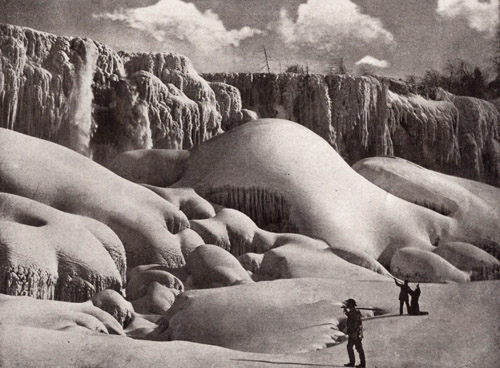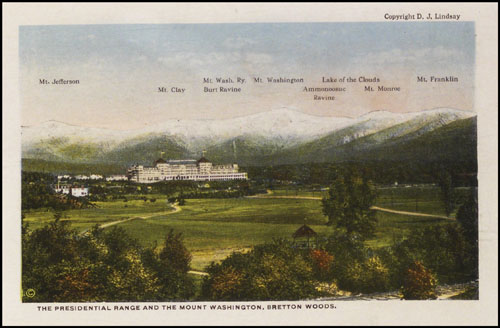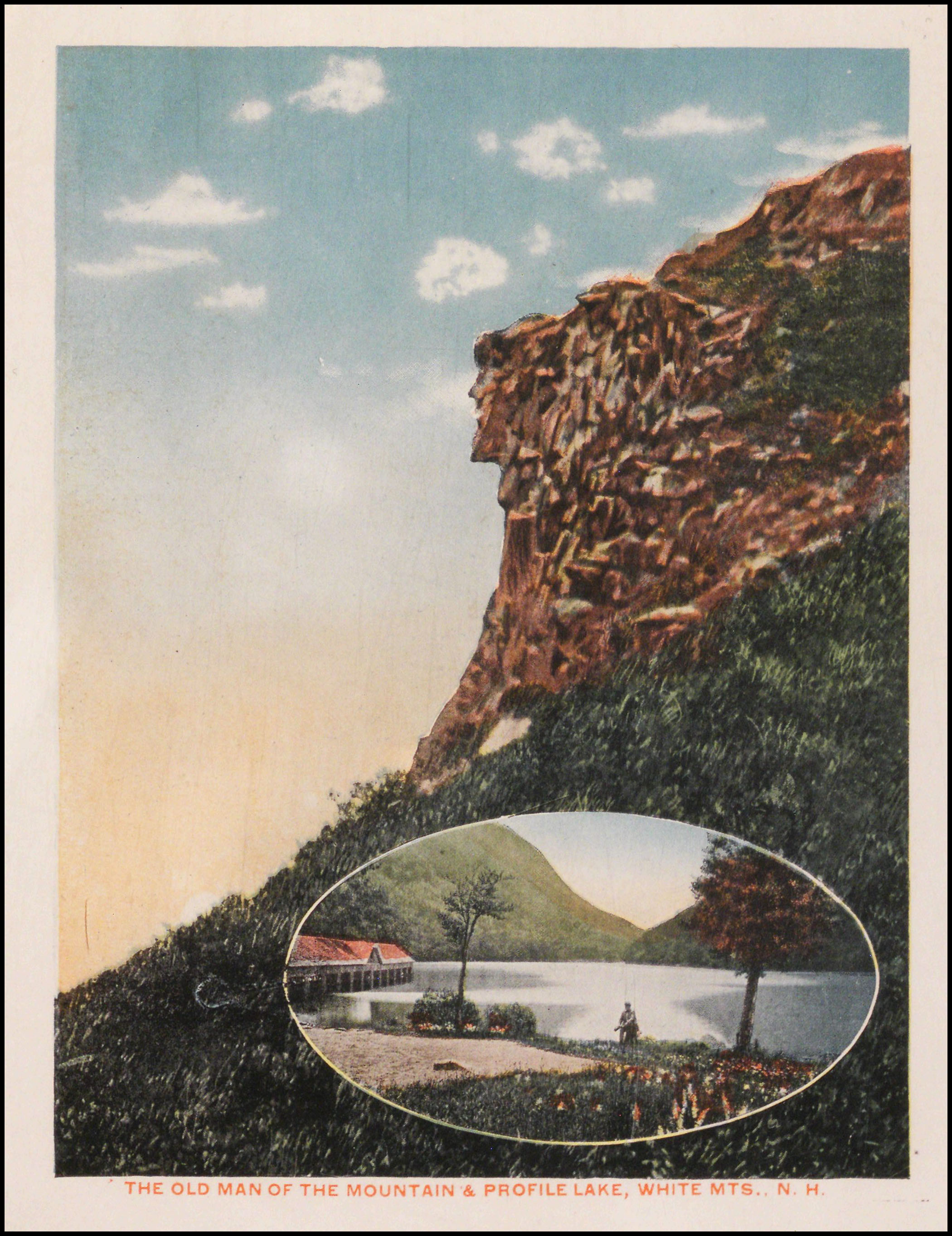Editor's Choice
The editorial team for Leisure, Travel & Mass Culture: The History of Tourism pick their top leisure destinations from within the collection.
Niagara Falls
Sarah Buckman
One of the great natural wonders, Niagara Falls has drawn people from all over the world to its cascades and swirling rapids since the mid-eighteenth century. However, it was not until the beginning of the nineteenth century that the area became a favourite tourist spot, particularly with the American ‘Grand Tourist’ on their way through New York and into Canada.
Many eyewitness descriptions from the great era of the American Grand Tour can be read in the travel journals within Leisure, Travel & Mass Culture: The History of Tourism. Striking examples include the account given by Elise Charlotte Otté on her excursion with ex-President John Quincy Adams in 1843 (to read more see Eyewitness Travels), the journal penned by Catherine Scollay in 1825 on her journey from Boston to Niagara and the notes kept by Unitarian Minister Samuel May in 1849, who describes, in detail, his travels to Niagara, his stay at the Cataract Hotel (the same accommodation Elise and her friends frequented six years earlier) and boat trips beneath the falls.
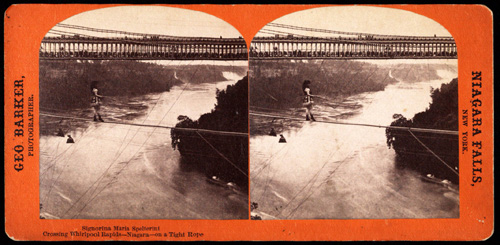 Signorina Maria Spelterini Crossing Whirlpool Rapids – Niagara – on a Tight Rope
Signorina Maria Spelterini Crossing Whirlpool Rapids – Niagara – on a Tight Rope
Copyright of this material is retained by the content creators. Michigan State University
does not claim to hold any copyrights to these materials
A favourite sketching spot for decades, Niagara became a focal point for amateur and professional photographers alike with the development of more widely available photographic technology. Canadian-American photographer George Barker’s famous stereographs from the collection at Michigan State University depict popular sights such as the Cave of the Winds, Bridal Veil, Horseshoe Fall and the whirlpool rapids and give us a sense of how astoundingly close nineteenth century travellers came to the steep plunges; some perhaps too close. One remarkable photograph depicts Signorina Maria Spelterini crossing the rapids on a tight-rope in July 1876 – the only woman to ever do so. Not content with attempting this daring feat once, Maria successfully completed it four time in the same month, including crossing blindfolded on 19 July.
Other photographs and view books depict the sheer breathtaking majesty of the falls. The Falls of Niagara, The Niagara Book, A Complete Souvenir of Niagara Falls and Niagara in Summer and Winter, to name but a few in the collection, are excellent mid-nineteenth century examples of souvenirs of the visit which keen sightseers could take home and cherish. Niagara in Summer and Winter even shows visitors at the base of the frozen rapids; an annual occurrence, but one that never ceases to amaze.
At the turn of the twentieth century therefore, Niagara was firmly on the map. In 1908 Thomas Cook’s American Tours provided round trip excursions from New York to Niagara by rail and steamboat for $15.00 (see Cook's American Tour Book. Tickets and Tours by Ocean, Lake, Rail, and River for Individual Travel). With the introduction of reasonably priced automobiles, the American Automobile Association (AAA) also included it as a popular destination in its Northeastern Tour Book, describing the falls as a “… magnificent spectacle” and providing details of all closest hotels and restaurants. Niagara's popularity remained strong throughout the twentieth century, with Poly Tours including it as a two-day stop on their 1959 American tour of the Eastern States (see Poly Holidays in Europe and America 1959).
Niagara Falls remains one of the most awe-inspiring spectacles to date and still attracts vast crowds of tourists keen to soak up the same majesty enjoyed by the Grand Tourists of old.
To see documents related to Niagara, click here.
Lucerne, Switzerland
Hayley High
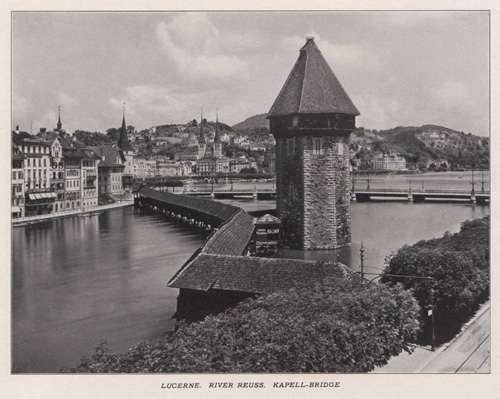 The lakeside city of Lucerne in Switzerland sits in the shadow of the Swiss Alps straddling the Reuss River. Since 1981, it has been twinned with the seaside town of Bournemouth in Great Britain and since 1999, with Chicago in the United States. It is not hard to see why Lucerne has been, and remains, a popular tourist destination; offering a blend of lakeside relaxation, boat trips, hiking and railway trips in the mountains and the sightseeing and shopping opportunities of a city break. As well as glorious scenery, the city itself boasts some beautiful architecture, including the Kapellbrücke (Chapel Bridge), the oldest covered bridge in Europe dating from the fourteenth century and the twin towered cathedral of St. Leodegar.
The lakeside city of Lucerne in Switzerland sits in the shadow of the Swiss Alps straddling the Reuss River. Since 1981, it has been twinned with the seaside town of Bournemouth in Great Britain and since 1999, with Chicago in the United States. It is not hard to see why Lucerne has been, and remains, a popular tourist destination; offering a blend of lakeside relaxation, boat trips, hiking and railway trips in the mountains and the sightseeing and shopping opportunities of a city break. As well as glorious scenery, the city itself boasts some beautiful architecture, including the Kapellbrücke (Chapel Bridge), the oldest covered bridge in Europe dating from the fourteenth century and the twin towered cathedral of St. Leodegar.
As early as 1886, the Polytechnic Touring Association began running their first ‘package-style’ tours to Lucerne, offering stays at their lakeside chalets. One guest at the Polytechnic Chalets in 1898 sent a postcard back to England depicting the accommodation and describing their experiences so far. The anonymous writer explains that a band and dancing were part of the entertainment, a concert was to be put on in the big dining salon and that the chalet grounds were illuminated at night. The writer also mentions a special bathing house just for women and that they plan to go shopping in Lucerne the next day.![[Switzerland Postcards] © Permission granted by University of Westminster Archive](/ContributeData/MassTourism/Views/Introduction/Editors Choice/West_PTA_2_4_2_22-38_0021.jpg)
The Polytechnic Touring Association offered an extensive excursion programme. In their ‘Lucerne General Notes and Excursion Programme’ booklet for customers, the P.T.A. offered a steamboat trip, followed by a train ride up to the summit of the Rigi, an automobile excursion to Andermatt, a trip to see several Swiss castles and a motor excursion to the Stalactite Caves at Baar. Perhaps recognising its ongoing popularity, the Polytechnic Touring Association also picked Switzerland as the destination for their first escorted tour by air on 14 May 1932.
By 1938, the P.T.A. were advertising the chalets as a “private estate of 100 acres” boasting hot water in every room, three meals a day and the ‘Red Arrow’, the “new speed-run to Lugano by the steam line express ... which you take at the special private halt that the Swiss Federal Railway has provided especially for PTA travellers.”
The Polytechnic Touring Association were not the only travel company to offer trips to Lucerne in the nineteenth century. For example, Thomas Cook included Lucerne on a Personally Conducted Tour to the Italian Lakes and Switzerland in 1890. On this tour, passengers would arrive at Lucerne by train, having first travelled through a landscape of “gorges, foaming torrents and lofty cascades descending from the mountain snows.” They would then spend two days sightseeing in the city, visiting bridges, the Glacier Garden and Lake Lucerne (Vierwaldstättersee), described in the brochure as “full of wild and picturesque scenery ... and associated with the legend of William Tell” (the Swiss Folklore hero). In 1950 Thomas Cook were still running tours to Lucerne, for Switzerland at its loveliest, offering a ten day holiday for the bargain price of £29, with depa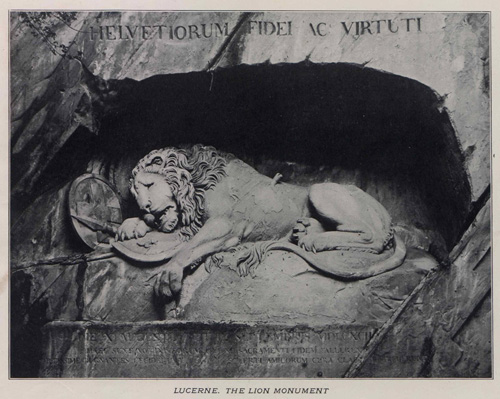 rtures by rail or by air and a choice of hotels.
rtures by rail or by air and a choice of hotels.
One of the more peculiar but most memorable landmarks in the city is the Lion Monument. This rock relief was designed by Bertel Thorvaldsen and carved by Lukas Ahorn in 1820-1821. The lion has been mortally wounded by a spear and is lying protectively over a shield bearing the Fleur-de-Lis of the French monarchy, next to another shield bearing the coat of arms of Switzerland. Appearing in many of the documents concerning Lucerne contained within Leisure, Travel & Mass Culture: The History of Tourism including postcards, photographs and guide books, the monument was built to commemorate the hundreds of Swiss Guards who were massacred at the Tuileries Palace in France during the French Revolution.
To see all documents related to Lucerne, click here.
The Rhine: Switzerland, Liechtenstein, Austria, Germany, France and the Netherlands
Jo Perdicchia
The Rhine river stretches from the Swiss Alps to the Netherlands, encompassing a 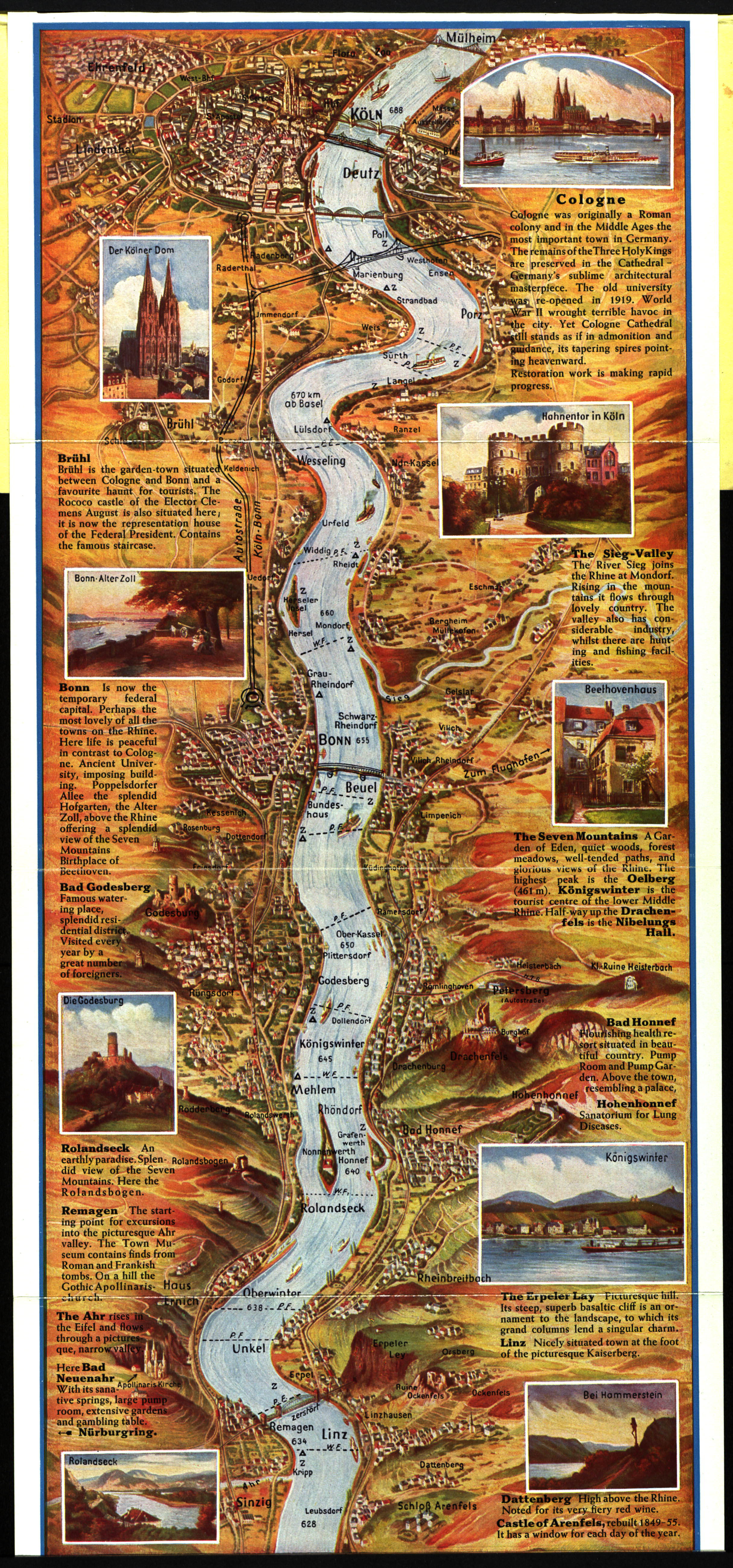 large section of Western Europe and consequently offering a vast number of impressive and beautiful tourist opportunities. Due to its vast geographic stretch, it functions not only as a beautiful natural sight but also as an essential waterway for trade in Europe. Descending as it does through notable European countries, its banks feature many famous tourist destinations that have been enjoyed by people from all over the world throughout history. Visitors to the Rhine could choose to explore castles, forests, vineyards, museums and monasteries as well as the larger areas along the Rhine Valley. Recognising both its economic and cultural importance, it was a point of contention between the countries it ran through for many years and the Rhineland in particular has been a source of national pride and identity for Germany and was used as a political and geographical tool by Allied forces following the First World War.
large section of Western Europe and consequently offering a vast number of impressive and beautiful tourist opportunities. Due to its vast geographic stretch, it functions not only as a beautiful natural sight but also as an essential waterway for trade in Europe. Descending as it does through notable European countries, its banks feature many famous tourist destinations that have been enjoyed by people from all over the world throughout history. Visitors to the Rhine could choose to explore castles, forests, vineyards, museums and monasteries as well as the larger areas along the Rhine Valley. Recognising both its economic and cultural importance, it was a point of contention between the countries it ran through for many years and the Rhineland in particular has been a source of national pride and identity for Germany and was used as a political and geographical tool by Allied forces following the First World War.
Documents from Leisure, Travel & Mass Culture: The History of Tourism show that tourists could enjoy many options for exploring the Rhine and its adjacent regions. As early as 1863 Thomas Cook detailed organised trips to the Rhine in the Excursionist periodical, where lucky tourists could travel with a group “from Hanwich to Antwerp, and thence to the Rhine”. The periodicals also describe various adventures, whereby intrepid explorers could tackle France and the “whole of Switzerland, from the falls of the Rhine to the summit of Mont Blanc” (Cook's Excursionist and International Tourist Advertiser, Series 13, No. 1-6). The Rhine was recognised as a desired destination and its offerings were enjoyed by some of the earliest undertakers of the package tour. The Lincolne Sisters' Rhine Trip from 1855 held in the Thomas Cook Archives shows their experience travelling through Holland, Belgium and the Rhine. On their trip, they enjoy the scenery, taste the food, visit cathedrals and monasteries and generally immerse themselves in European culture. It is a classic trip to the region enjoyed by three young women.
The draw of the river was not just felt by Europeans however, but also by their neighbours across the pond. Brochures from California Historical Society show advertisements for European trips to see the sites, amongst them the Italian Lakes, Paris, London and the Rhine. Organised in 1882 by Cook, Son and Jenkins, a small party of American tourists could leave New York for a 79 day tour of Europe for the reasonable price of $550 (or about $12,500 in today’s money) (see Particulars of a Tour to California, Colorado and the Yosemite Valley. To Leave April 17th and Return on the 2d of June 1882).
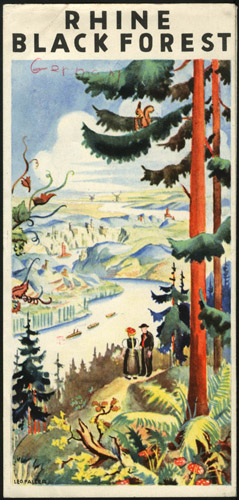 Exclusive package tours aside, the area around the Rhine was not just reserved for those who could afford it, although not everyone from the less wealthy end had a positive experience. The UK’s Camping and Caravanning Club dedicated many column inches to giving people advice on camping and cycling in Britain and further afield. An issue of their periodical in 1910 highlights, however, that camping in Europe was not always a favourable experience. The reader C. H. P. writes to complain and advise others that camping along the Rhine is not a favourable option for an intrepid camper. In his eight day trip along the river, he is not allowed to pitch anywhere on the first night, finds gawking passer-by’s outside his tent on the second night and fails to find anywhere else to camp for the remaining five. He blames this failed trip on “the country classes [being] brusque and suspicious, and not to be compared with the same class in our own country.”
Exclusive package tours aside, the area around the Rhine was not just reserved for those who could afford it, although not everyone from the less wealthy end had a positive experience. The UK’s Camping and Caravanning Club dedicated many column inches to giving people advice on camping and cycling in Britain and further afield. An issue of their periodical in 1910 highlights, however, that camping in Europe was not always a favourable experience. The reader C. H. P. writes to complain and advise others that camping along the Rhine is not a favourable option for an intrepid camper. In his eight day trip along the river, he is not allowed to pitch anywhere on the first night, finds gawking passer-by’s outside his tent on the second night and fails to find anywhere else to camp for the remaining five. He blames this failed trip on “the country classes [being] brusque and suspicious, and not to be compared with the same class in our own country.”
Despite these potential pitfalls, the Rhine continued to be a popular tourist destination and into the latter half of the century travel companies were advertising tours by motor car, as seen in the Travel Plans – Great Car Tours brochure published by Travel Plans International Inc. It has not lost its draw over the years and ways to explore it have been continually developed in accordance with the expansion of transport, package tours and independent travel.
New Orleans, Louisiana, USA
Hayley High
New Orleans, also known as ‘the Big-Easy’, is the largest city in the state of Louisiana and has a very interesting history. It was founded as a French colony and named after the French Duke of Orleans on 7 May 1718, but by 1763 the French had ceded the city to the Spanish Empire as part of the Treaty of Paris. Although it was returned to them briefly in 1803, Napoleon Bonaparte sold the whole state of Louisiana (New France) to the United States in the Louisiana Purchase later that same year! As a result, the city of New Orleans is well known for its mix of cultures, a legacy which was only increased by the later influx of African, American, Creole, Irish, Italian and German immigrants. This in turn has led to the appearance of diverse music, food, art, religious beliefs and values in the city.
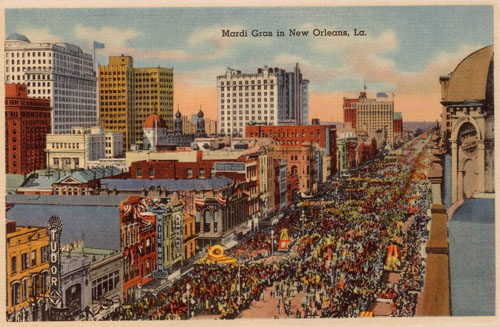 New Orleans is perhaps most famous for its nightlife, live music (it is after all the birth place of Jazz), festivals and of course Mardi Gras. Mardi Gras was originally a French Catholic tradition, reportedly first celebrated in Mobile, Alabama in 1703, by some of the first French settlers. The first Mardi Gras parade through New Orleans took place in 1837. Some of the city’s most famous landmarks also provide an insight into its mixed cultural heritage. For example, the Vieux Carré (French Quarter), Jackson Square and the St. Louis Cathedral, the Spanish Fort, various plantation homes, the Cabildo Museum (originally the seat of the Spanish Government), the Confederate Museum, the Maritime Museum and, since 1972, the New Orleans Historic Voodoo Museum.
New Orleans is perhaps most famous for its nightlife, live music (it is after all the birth place of Jazz), festivals and of course Mardi Gras. Mardi Gras was originally a French Catholic tradition, reportedly first celebrated in Mobile, Alabama in 1703, by some of the first French settlers. The first Mardi Gras parade through New Orleans took place in 1837. Some of the city’s most famous landmarks also provide an insight into its mixed cultural heritage. For example, the Vieux Carré (French Quarter), Jackson Square and the St. Louis Cathedral, the Spanish Fort, various plantation homes, the Cabildo Museum (originally the seat of the Spanish Government), the Confederate Museum, the Maritime Museum and, since 1972, the New Orleans Historic Voodoo Museum.
Leisure, Travel & Mass Culture: The History of Tourism contains many brochures and leaflets for the city, from the nineteenth to twentieth centuries, 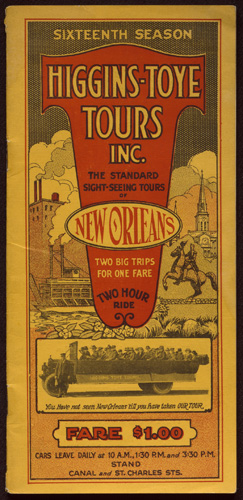 which cover places to eat and drink, along with recommendations of where to stay. For example, Dunbar's. Distinctive Creole Cuisine, Les Patisseries aux Quatre Saisons (Four Seasons), The Royal Orleans Hotel and Marie Antoinette Hotel. The collection also has a large number of general guidebooks of the city including: A Condensed History of New Orleans, The Times-Picayune Tourists' Guide to New Orleans and The New Orleans Leisure Guide.
which cover places to eat and drink, along with recommendations of where to stay. For example, Dunbar's. Distinctive Creole Cuisine, Les Patisseries aux Quatre Saisons (Four Seasons), The Royal Orleans Hotel and Marie Antoinette Hotel. The collection also has a large number of general guidebooks of the city including: A Condensed History of New Orleans, The Times-Picayune Tourists' Guide to New Orleans and The New Orleans Leisure Guide.
New Orleans has long drawn visitors with an impressive number of sightseeing opportunities and what easier way to see them than a guided tour. Leisure, Travel & Mass Culture: The History of Tourism includes examples of brochures and leaflets advertising the different ways to see the city’s sights. Tourists can travel by boat on the Mississippi (Visitor’s Guide to New Orleans: Seeing New Orleans' The Unique Water Way), by motor car (Original Cookes Tours of the City. The Right Way to See New Orleans), by motor coach (Higgins-Toye Tours, Inc. the Standard Sight-seeing Tours of New Orleans. Two Big Trips for One Fare. Two Hour Ride. Sixteenth Season) or on foot (A Trip Thru Old New Orleans).
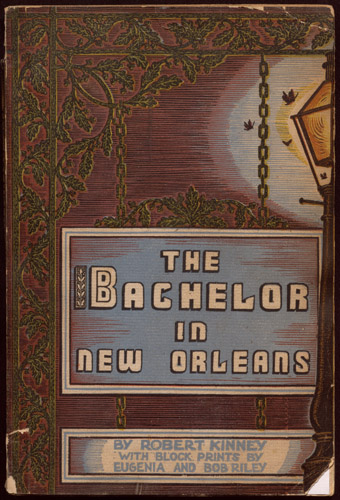 One item in particular stands out from the crowd for me; a booklet entitled The Bachelor in New Orleans, written by Robert Kinney in 1942. This tongue-in-cheek, witty, ‘guidebook’ advertises itself as a “handbook for those not afraid to find out for themselves”. It provides advice on many areas of interest to the adventurous bachelor; including recommendations for the best drinking establishments, gourmet restaurants and how to avoid ‘loneliness’ during an evening’s entertainment. The author is, for example, very complimentary about Antoine’s Restaurant in the French Quarter, describing how “many bachelors in New Orleans go [there] as pilgrims to a shrine … dinner here is an experience the Bachelor in New Orleans will never, never forget.” He also names several of the most popular drinks to be ordered, such as the ‘Zombie’, “you can recognize him not only by his terrific kick – one of the rums in his veins is 151 proof – but by the violent red of his diapers!”, or “the quiet-voiced and polite but potent Café Lafitte Special … there are applejack and curacao, among other nice things, in the blood of this comer”. Or perhaps the “handsome red Sazerac, a smooth-voiced guy with a terrific right and a wicked left to boot … whiskey, Peychaud and Angostura bitters, and a whiff of absinthe combine to make him a fine friend but one hell of a guy with whom to go to the ropes” would be first on the list to try.
One item in particular stands out from the crowd for me; a booklet entitled The Bachelor in New Orleans, written by Robert Kinney in 1942. This tongue-in-cheek, witty, ‘guidebook’ advertises itself as a “handbook for those not afraid to find out for themselves”. It provides advice on many areas of interest to the adventurous bachelor; including recommendations for the best drinking establishments, gourmet restaurants and how to avoid ‘loneliness’ during an evening’s entertainment. The author is, for example, very complimentary about Antoine’s Restaurant in the French Quarter, describing how “many bachelors in New Orleans go [there] as pilgrims to a shrine … dinner here is an experience the Bachelor in New Orleans will never, never forget.” He also names several of the most popular drinks to be ordered, such as the ‘Zombie’, “you can recognize him not only by his terrific kick – one of the rums in his veins is 151 proof – but by the violent red of his diapers!”, or “the quiet-voiced and polite but potent Café Lafitte Special … there are applejack and curacao, among other nice things, in the blood of this comer”. Or perhaps the “handsome red Sazerac, a smooth-voiced guy with a terrific right and a wicked left to boot … whiskey, Peychaud and Angostura bitters, and a whiff of absinthe combine to make him a fine friend but one hell of a guy with whom to go to the ropes” would be first on the list to try.
There is also a chapter about attending Mardi Gras, which explains that “the spirit gets you, you can’t escape … you look down and find your feet performing a rapid dance as they move you straight for the nearest bar.” However, after such a raucous night, it is suggested that on Ash Wednesday the discerning bachelor should attend church as “you have been a bad lad, but so has everyone in New Orleans, practically. Here you will find the saddened sinners not outnumbered by the righteous”. This is then immediately followed by the suggestion that once the church service is over “it might not hurt to have one, just one, or perhaps two, in the closest congenial bar. With a drink or so in you, you will begin to feel better, possibly. Not unrepentant, of course, but better, healthier.”
The White Mountains, New Hampshire, USA
Fancy some fresh air, fine scenery and oodles of adventure? Are your holidays all about action packed activities, stretching your legs and admiring some of nature’s most exquisite creations? Then you might want to consider a trip to the White Mountains.
Part of New England’s rugged Appalachian Mountain range, the White Mountains cover around a quarter of New Hampshire. The range boasts a number of national parks replete with lakes, waterfalls and dense forest, as well as the famous Mount Washington, the highest mountain in north east United States, nestled within the Presidential Range. In total, there are 48 peaks over 4,000 feet high. The range is also within easy reach of Boston and New York, so was discovered by tourists early on during the development of the railroads.
There is very little you cannot do in the White Mountains and Leisure, Travel & Mass Culture: The History of Tourism shows that holidaymakers have been making use of the area’s leisure opportunities since the early 1800s. Walking through, and climbing up, the range’s famous peaks was one obvious draw and travel journals such as a Short Journal of a Trip to the White Mountains of New Hampshire in 1837 by Maria Webber, Excursions to the White Mountains with Dr. Aaron Ordway's Parties of '75 and '76 and With Pen and Camera Thro' the White Mountains, describe journeys taken by foot, horse, railroad and car, taking in local landmarks such as the Old Man of the Mountain and spectacular mountain passes like Franconia Notch.
Travellers requiring more than a challenging climb and breath-taking scenery could benefit from the wide range of sporting facilities that began to develop in the region; particularly in the winter. The range’s snow-capped mountains provide perfect conditions for skiing, snowshoeing, tobogganing and skating. By the 1940s, winter sports infrastructure was well established, with ski lodges and facilities developing in places such as Pinkham Notch, Franconia Notch and Cranmore Mount. Brochures such as Vacation in Winter. White Mountains of New Hampshire and Winter in Pinkham Notch wax lyrical about the unforgettable skiing experience in the White Mountains and publications such as Ski Lure were dedicated to recording traveller experiences of the wintry peaks.
The White Mountains are not just about endless adventure – the area also became famous for its hotels. The region had always been kind to weary travellers, with inns and taverns playing host to dusty riders for years before the development of the railroad. However, with the influx of tourists, grand resort hotels sprang up throughout the region such as the Mount Washington Hotel,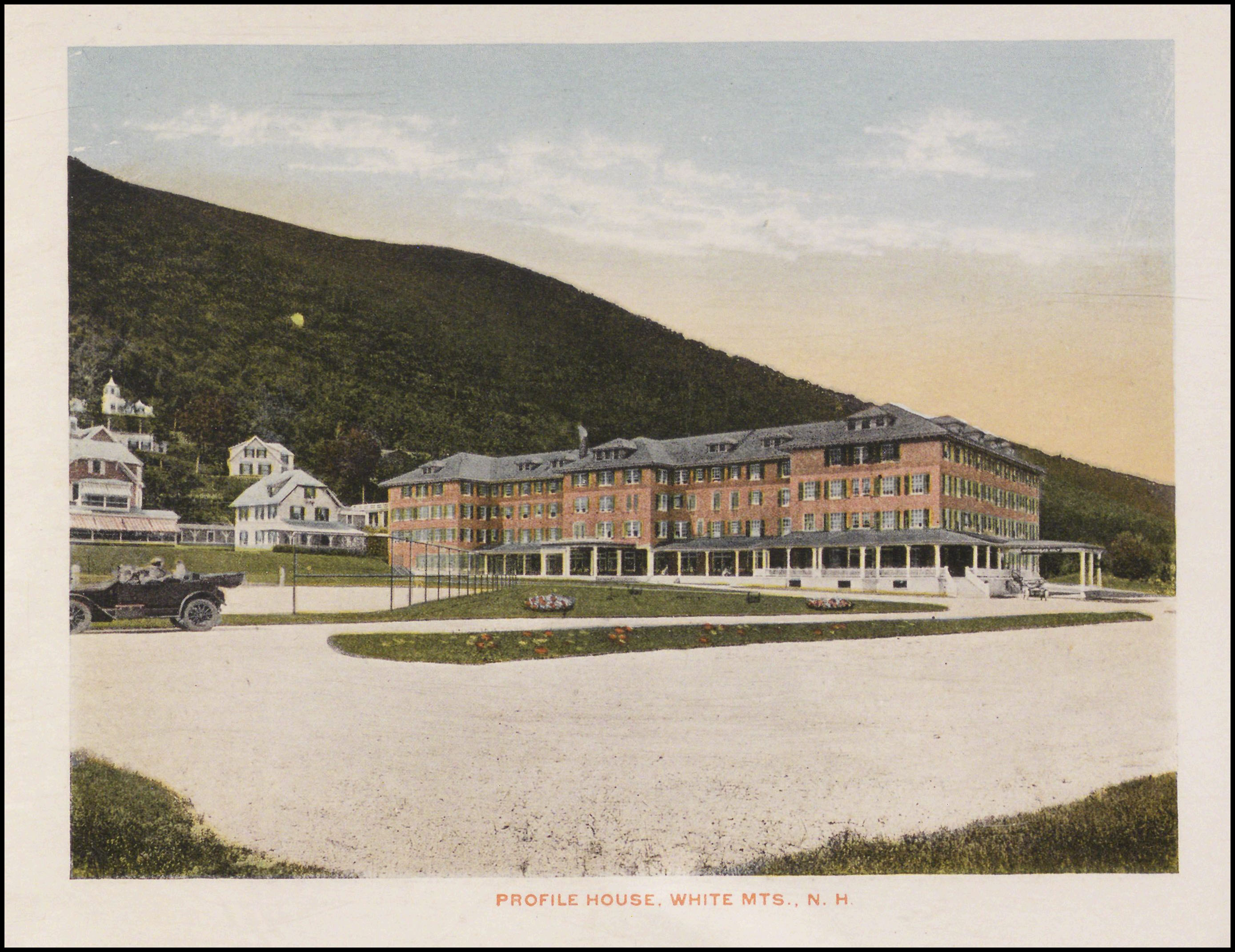 Mount Pleasant House, Eagle Mountain House, Profile House and Fabyan’s, offering greater luxury and convenience to those wishing to come and sample the mountain air without Camping in the White Mountains!
Mount Pleasant House, Eagle Mountain House, Profile House and Fabyan’s, offering greater luxury and convenience to those wishing to come and sample the mountain air without Camping in the White Mountains!
This enormous range of holiday potential has resulted in a multitude of fascinating documents recording holidaymakers’ experiences of this rich landscape; from travel diaries, guidebooks, personal and professional photo albums to leaflets advertising the beautiful hotels and package tours offered by companies such as Thomas Cook. The White Mountain’s popularity never diminished, with the area still welcoming millions of visitors every year, proving itself a timeless holiday destination.



